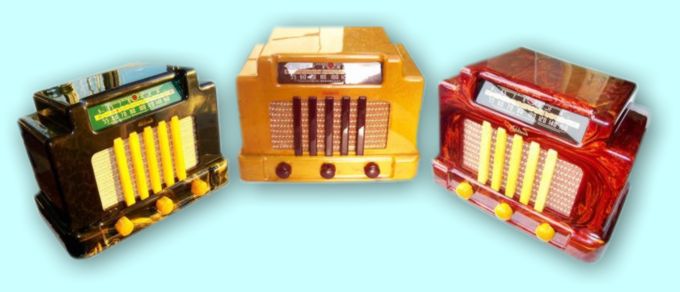|
"The Courthouse", Canada's Iconic Catalin Radio from 1940, in Butterscotch, Mint Serviced and Working. Green and Red Versions also available
In a Nutshell
All three versions of this radio are for sale - here is the Butterscotch one (center). It has no chips, cracks, discolorations, scratches whatsoever and works fine

Introduction:
Of the five prewar plastics catalin, beetle, urea, plaskon and bakelite, catalin is the "gem of plastics", followed by beetle, a beautiful special type of plaskon. Radios made from catalin are fetching by far the highest prices, because this material is most subject to material shrinking, causing many of their cabinets having developed cracks, especially when (non-shrinking) chassis' have been screwed too tightly to the cabinets. Catalin is the only material, that could be made in all colours, mostly with two or three of them mixed into swirling patterns (pict.156) and often translucent, as is the case for this radio (pict. 9).
The American Catalin Corporation, following a German recipee, began producing catalin casts in 1927, the very same year that Dr. Leo Baekeland's bakelite patent expired, in New York. Production was suspended in 1942. Catalin was introduced for radio cabinets in the 1930's in order to make radios cheaper than wooden radios, and more attractive than bakelite radios. Typical prices for a bakelite, catalin, or wood radio were $10, $40, and $100, respectively. Today a blue Fada Bullet radio is in the price guides for $5000 and fetches on eBay $3000, a little green Motorola Circle Grille radio was sold for $18'000 a few years ago at an auction in New York. Catalin was also used for vintage fashion accessories and fine, expensive jewelry.
The Canadian Addison made two catalin models, the 5F ("Courthouse") and the 2A ("Waterfall"). Both of these models were also made in other materials such as styrene, plaskon, bakelite, and even wood, and are icons of Canadian commodity design.
Additional information:
ref. 1. http://www.catalinradio.com/gallery
ref. 2. http://celluloidforever.com/BakeliteandCatalin.html
About my radio:
Butterscotch versions of catalin radios are normally the most affordable ones within all colour variants for a certain model. Not so for this Addison 5 - this is because this version was produced in much smaller numbers than the red and green versions, and therefore is quite rare. Butterscotch catalin normally was white alabaster, when new and has aged to turn yellow. And this is the tone collectors appreciate most. My radio has a very uniform yellow tone with darker and even some maroon swirls in it, that best can be seen in transmission light (pict.s 15, 16, 18). The radio is in mint and original condition, having no chips, scratches, cracks, or discolorations whatsoever. I did not polish the cabinet, not to remove the thin alcohol layer deposited over time, giving it the smooth butterscotch tone (see techies below). The dial glass is new (the last in stock at radiodaze) but indistinguishable from an original and in perfect shape. If wanted, an original dial glass in green can be substituted. The chassis has been thoroughly cleaned and in-depth serviced. All moving parts have been treated with contact spray. The filter capacitors and one resistor have been replaced. The radio plays loud and clear on AM/BC, where it has good sensitivity and selectivity over the whole band spread, and receives on short-wave. Please
e-mail me (Kris) for any questions, ich spreche Deutsch, je parle Français.
For the techies only:
Catalin, like bakelite is a phenol formaldehyde resin, but unlike bakelite does not use fillers and is cast at much lower temperatures and not under pressure, thus allowing a full colour spectrum. Objects from catalin can be easily recognized by their thicker wall thickness, and from their colour transformations with increasing age. Catalin with time (a few years only!) and under the influence of UV light, develops a very thin surface layer of phenyl alcohol, which is brown and can be easily removed with practically any plastic cleaner. Common wisdom is: try it, and you will be amazed by the result, but never ever try it without extensive testing on a butterscotch coloured object, since it will turn it back into its original white alabaster look, which is disliked by most collectors.
Here are the specifications:
Technical Description of Item |
| Manufacturer |
Addison Industries Ltd., Toronto, Canada |
| Model |
5F, chassis R5A3 |
| Type |
5-tube AM/BC and SW Superheterodyne Receiver |
| Production Year |
1940 |
| Serial Number |
67194 |
| Cabinet |
Yellow - maroon swirled catalin, 5 maroon catalin bars on speaker grille |
| Dial |
Illuminated reverse painted glass |
| Knobs |
3 maroon pinwheel catalin knobs |
| Frequency Range |
AM 550-1600 kHz, SW 6-15 MHz |
| Controls |
Volume - on/off, tuning, band switch |
| Tube line-up |
35Z5(Rect), 12SA7(RF), 12SK7(IF), 12SQ7(Det.), 50L6(Audio) |
| Size (WxDxH) |
12" x 7" x 8¾" |
| Weight |
8 lbs = 3.6 kg |
| Comment |
Like new condition, serviced and perfectly working |
|




